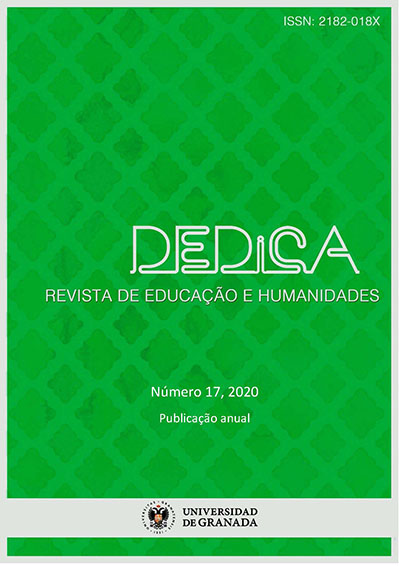Formación para la equidad de género: una experiencia mediante coreografías en el Grado de Educación Infantil
DOI:
https://doi.org/10.30827/dreh.v0i17.7909Palabras clave:
coreografías, Educación Infantil, movimiento con música, música, temas transversalesResumen
INTRODUCCIÓN. En Educación Infantil, el trabajo de los denominados temas transversales toma especial relevancia porque permiten reforzar las destrezas del alumnado en diferentes áreas, que contribuyen a un desarrollo adecuado durante la Educación Primaria. Los contenidos de la asignatura “Procesos musicales en Educación Infantil”, de tercer curso del Grado de Maestra de Educación Infantil, permiten el trabajo de esos temas, concretamente, las coreografías. Éstas pueden ser utilizadas como herramientas lúdicas que garantizan no sólo el trabajo de las habilidades motrices básicas, sino también la equidad, la educación cívica y moral…, por el contenido de las canciones que pueden ser utilizadas para los montajes coreográficos. Atendiendo a esto, el objetivo de la experiencia se centró en convertir las coreografías en herramientas de trabajo de temas transversales y no sólo en las habilidades motoras.
METODOLOGÍA. Se partió de la organización del grupo-clase como grupo de discusión, tratándose las consideraciones de sus figuras familiares femeninas respecto a lo que esperan de ellas como mujeres, y del grupo-clase de discusión posterior a las diferentes audiciones, cuyas temáticas fueron analizadas. Después, se dividieron en grupos para la preparación de las coreografías con canciones seleccionadas libremente por cada grupo; y, finalmente, se analizaron las coreografías realizadas para conseguir cierto feedback entre los distintos grupos. Las coreografías debían incluir las habilidades motrices básicas como elementos de trabajo principal.
RESULTADOS Y DISCUSIÓN. Los datos recogidos mediante los grupos de discusión, con el análisis de las coreografías y analizando las impresiones individuales recogidas en el Dossier final de la asignatura, muestran que no todos los grupos realizaron coreografías con canciones respetuosas con la mujer y tampoco plantearon coreografías cuidadas respecto a las habilidades motrices básicas.
CONCLUSIONES. Pueden reducirse a dos: las estudiantes consideraron necesario ampliar sus conocimientos para llegar a desarrollar mecanismos adecuados para la selección del repertorio acorde con los temas transversales y consideraron necesario ampliar el tiempo de formación musical para poder manejarla como herramienta de trabajo de todas las áreas del currículo de Educación Infantil.
Descargas
Citas
Azorín, C. Mª & Vicente, G. (2012). Opus Solidaridad: trío para música, educación y valores. Espiral. Cuadernos del profesorado, 5 (10), 78-86.
Cabedo, A. & Arriaga, C. (2016). ¿Música para aprender, música para integrar? Arte y educación en valores en el currículo escolar. DEDiCA, 9, 145-160.
Chaves, M. (2013). Música, educación y arte. Artseduca, 5, 1-24.
Cuellar, M. (1998). La enseñanza de la danza. Principios didácticos y orientaciones metodológicas para su aplicación. El patio de Asernef, 3, 11-14.
Del Río, D. (2003). Métodos de investigación en educación. Volumen I. Procesos y diseños no complejos. Madrid: Universidad Nacional de Educación a Distancia.
Díaz, M. L., Morales, R. & Díaz, W. (2014). La música como recurso pedagógio en la edad preescolar. Revista Infancias Imágenes, 13 (1), 102-108.
Espinosa, M. & Ureña, N. (2014). La evaluación de las habilidades motrices básicas en niños de 3 y 4 años de educación infantil. En P. Miralles, Mª B. Alfageme & R. A. Rodríguez (Eds.), Investigación e innovación en Educación Infantil (pp. 319-328). Murcia: Universidad de Murcia.
Esteve, A. I. & López, V. M. (2014). La expresión corporal y la danza en educación infantil. La Peonza, 9, 3-26.
Estrada, O. (2012). El profesor ante la formación de valores. Aspectos teóricos y prácticos. Teoría de la Educación. Educación y Cultura en la Sociedad de la Información, 13 (3), 240-267.
Fort, O. (2015). Cuando danza y género comparten escenario. Revista para la investigación en arte, 3 (1), 54-65.
González, M. M., Perandones, M., Rodríguez, G. A. & Le Barbier, E. (2015). Estrategias expresivas, interdisciplinariedad y convivencia desde la educación musical. DEDiCA, 7, 143-162.
Herranz, A. & López, V. M. (2015). La expresión corporal en educación infantil. La Peonza, 10, 23-44.
Llamas, J. C. (2005). La violencia contra las mujeres en las canciones populares: una propuesta didáctica para tercer ciclo de educación primaria. Eufonía, 34, 111-122.
Madero, Mª D. & Gallardo, I. Mª (2016). Educación para la paz y la ciudadanía desde la música como lenguaje universal de las emociones. Boletín Redipe, 5 (9), 5-9.
Marín, V. & Solís, C. (2017). Los valores transmitidos por las mujeres de las películas Disney. Revista CS, 23, 37-55.
Martínez, I. C. & Epelde, J. (2012). ¿Cómo se construye la experiencia intermodal del movimiento y la música en la danza? Relaciones de coherencia en la performance y en la recepción de frases de música y de movimiento. Cuadernos de Música, Artes Visuales y Artes Escénicas, 7 (2), 65-82.
Ministerio de Educación (2006). Real Decreto 1630/2006, de 29 de diciembre, por el que se establecen las enseñanzas mínimas del segundo ciclo de Educación Infantil. BOE (04/01/2007), número 4, referencia 185, pp. 474-482.
Pastor, R. (2017). Danza creativa-educativa: hacia una pedagogía de la danza en la diversidad, la inclusión y la equidad. En B. Martínez, A. Mª
Díaza, J. L. Chinchilla y G. González (Coords.), Danza, investigación y educación: Género e inclusión social. (pp. 85-98). Málaga: Editorial Libargo.
Pérez Aldeguer, S. & Leganés, E. N. (2012). La Música como herramienta interdisciplinar: un análisis cuantitativo en el aula de Lengua Extranjera de Primaria. Revista de Investigación en Educación, 10 (1), 127-143.
Pérez Herrera, M. A. (2015). Educación de la experiencia sensoriomotora. Una Didáctica Constructivista Alternativa de la Música. Horizontes Pedagógicos, 17 (2), 88-103.
Quintanar, L. (2017). Explorando la educación ambiental en México, a través de letras de canciones. DELOS: Desarrollo Local Sostenible, 10 (30).
Rueda, B. & Párraga, J. (1995). Formes musicals i tècniques corporals: Percepció del espai I estructures rítmiques. Aplicacions i fonaments de les activitats físico-esportives. Lérida: INEFC.
Singer, R. N. (1975). Myths and truths in sports psychology. New York: Harper & Row.
Viciana, V., Conde, J. L. & Martín, C. (2000). Propuesta metodológica para la enseñanza globalizada de la educación corporal y musical en las etapas de infantil y primaria. Eufonía, 18, 83-89.












